We spend thousands of dollars on the best cameras and lenses, but we often forget about the smaller accessories that come between us and our subject. Switching out your eyepiece for something better is an extremely underrated and cheap improvement you can make, and from special coatings to magnifiers, you actually have a few more options than you may have known.
From eyepieces to actual optical viewfinders, Nikon’s lineup seems to be the most robust, so we’ll start there. Sony, Fujifilm, and other similar brands tend to only offer eye cup replacements as opposed to actual eyepiece substitutes (with different glass), but Canon does also have a few actual eyepieces that we’ll cover briefly at the end in relation to everything else. If you’re in any of the non-Nikon camps, feel free to skip ahead to the end. Or, read through and discover what you’re missing out on and why everyone that really matters shoots Nikon (kidding, kidding! Relax!).
Nikon Eyepieces: Rectangles or Circles
Nikon’s eyepieces come in two main categories: rectangular and circular. All of Nikon’s consumer and prosumer bodies make use of the rectangular eyepieces (the D750 is the highest-end DSLR with such a finder), while Nikon’s professional bodies take advantage of the circular shape that I actually prefer. This personal preference goes beyond that for just the shape, but is also due to the increased options of glass that Nikon has for its pro bodies.
Professional Circular Eyepiece Options
DK-17
The DK-17 is the base of all of Nikon’s circular eyepieces. It’s what ships with your Nikon D700, D800/D810, Df, D2 or newer full-body camera (we’ll get into one slight exception later, hint: notice an omission yet?), and even with the F6 film SLR.
There’s nothing too special about this eyepiece. It’s circular, it’s glass, it does what it’s made to do, and it works. If you’ve scratched up your current DK-17 as I did on my F6 and don’t want anything better, this is what you’ll want. But for a slightly increased investment, you have a number of better options.

Nikon DK-17 standard circular eyepiece.
DK-17F
This is my favorite eyepiece of them all, and it’s brand new. Nikon semi-quietly released this eyepiece alongside the D5 and D500 cameras (now we’ve arrived at the aforementioned exception) with which the DK-17F comes standard.
This time, Nikon made use of its fluorine-coating technology that many manufacturers have used to coat the front elements of a number of high-end lenses (especially those with large front elements). The fluorine coating allows oil, dirt, and water to repel off the glass extremely easily. The DK-17F won’t get dirty nearly as quickly as its counterparts, and when it does, a simple wipe should do the trick for just about any grease and grime.
A Nikon technical representative would have me believe the DK-17F is specifically and solely for use with the D500 and D5 bodies, and a Samy’s rep swore the DK-17F has been around for years. But as with many new, slightly obscure accessories, there’s plenty of misinformation out there.
Yes, the DK-17F is new. And yes, of course you can use it on any body that uses the DK-17 as its standard eyepiece — naturally, the thread and overall size of the piece are identical to the standard version. With the release of the D5 and D500, one wonders if this will indeed become the standard and if the DK-17 will be phased out.
So far, the DK-17F has been working amazingly on my F6 since I replaced its previously scratched up finder. The difference is night and day. And the grease-wicking features worked as promised — no need to huff hot air onto the eyepiece and work the corner of your shirt into all the nooks and crannies.

Aside from the microscopic bits of dust from the first few minutes out in the atmosphere lit up by the sun, any new eyepiece will look crystal clear when it's first installed. But the DK-17F is particularly handy thanks to its oil, dirt, and water-wicking features that help keep it clean at all times.
DK-17A
The DK-17A is a specially coated version of the standard DK-17 that is best in conditions of rapidly changing temperatures. The anti-fog coating on the glass in this piece helps keep the viewfinder from fogging up in a variety of conditions on either end so you can keep shooting — provided that your lens isn’t fogged up either. Because of body heat and evaporating sweat, it’s possible, however, that a standard eyepiece might become fogged over while your glass stays clear. So this is why you might want the DK-17A.

DK-17M
I’ve always loved the large viewfinders of medium format cameras. As good as my professional DSLRs’ viewfinders were, they just can’t match that giant medium format finder. So when I learned there was a magnifying eyepiece that could increase the size of the image in the viewfinder, I was immediately intrigued.
The DK-17M incorporates a 1.2x magnifying element within its glass, and it certainly magnifies your view. Subjects are gorgeous when looking through the DK-17M, but I did find the 1.2x magnification to be just slightly too much. I’m okay with parts of the finder being a bit harder to see, but at 1.2x, you really start to lose complete site of the corners, and the edges of the frame are a bit difficult to maintain in view. The in-finder LCD readouts also start to get cut off with the DK-17M. I really do wish the DK-17M came in a 1.1x version to provide the best compromise, but if you’re okay with losing a touch of the edge of your frame, it’s a pretty nice experience.

Do also note, however, that the DK-17M isn’t a small, thin disk as are the other pieces in the lineup. It has about a half-inch of thickness to it, and that will stick out and push against your bag if space is already tight in there. It’s not a huge deal, but it is something you might have to plan for. On the bright side, these extra few millimeters do keep the camera from smashing up against your cheek and nose as you shoot.

The DK-17M is a bit bulkier than your standard slim eyepiece. But for the right use, it's a great tool to have.
Correction Pieces (DK-17C and DK-20C)
Most of today’s modern DSLRs feature built-in diopters that offer a short range of adjustments for eyeglass wearers so they can focus and see clearly through the viewfinder without wearing their glasses. For photographers that need more than the built-in range (most Nikon professional DSLRs offer a range of -3 to +1, while some consumer models only go down to -2), Nikon offers an array of additional correction pieces that can be added to your viewfinder.
There's not a great way to read these numbers without getting confused, since the “default” of Nikon’s cameras without built-in diopter settings is always -1, as this is supposedly the most common setting for most people. Therefore, if your prescription is truly 0, you would need a +1 correction. However (here’s the really confusing part), Nikon’s correction pieces are numerically labeled according the final correction value you will get if attaching that piece to the standard Nikon viewfinder. Therefore, there is no -1 correction piece since this is the default for Nikon’s cameras. A “0” correction piece is not plain, normal glass. It’s actually a +1 correction piece that will result in a net 0 change according to your actual prescription (obviously, 0 means there is no prescription). If you don’t have a prescription, however, don’t be alarmed at the default setting. Again, a setting of -1 is almost always adequate for people of normal vision (don’t ask me how).
If you require a correction past the range of -3 to +1 for your camera that features an adjustable diopter, in some cases, you can combine a maxed-out setting on your camera with an additional external correction piece for a greater change from the standard setting (i.e. going all the way to -3 on the D5’s diopter setting and then adding a -3 correction piece could get you to an end result of -5; remember, the -3 correction piece is only a -2 change from the camera’s built-in -1 value). But this supposedly only be done on some cameras (check your manual for more information).

This chart matches your prescription level with the correct Nikon correction lens to get for your camera body. Do note that in many cases, your camera may have a built-in diopter that can and should be used to set the correct value for your needs.
It is still recommended that you use the built-in diopter when possible. Where this isn’t possible, it’s recommended to leave the camera’s setting at the default value, and to simply get a +3 correction piece if this is your prescription setting. But you should not/cannot combine external correction pieces with each other.
There’s no doubt that this is confusing stuff. If you require a major change in your diopter’s value, it’s highly recommended to simply take your camera to a store that can help you out.
Correction eyepieces are available in numerical values from -5 to +3 (DK-20C: -5 to DK-20C: +3) for rectangular eyepiece cameras and from -3 to +2 (DK-17C: -3 to DK-17C: +2) for circular eyepiece cameras (the rectangular pieces have more range because those cameras are the only ones that may not have built-in diopters).
Prosumer/Consumer Rectangular Eyepiece Options
DK-20s
Anything in the DK-20s is for a rectangular viewfinder. However, these vary a bit between certain models. The DK-20, 21, 23, and 24 are all standard eyecup replacements for various consumer/prosumer cameras. The DK-22 missing from this list is an odd-ball exception that is simply an adapter that allows the unusual DG-2’s thread to screw into and adapt to a rectangular eyepiece.

Nikon DK-22 adapter for the DG-2. Adapts screw-on DG-2 attachment to rectangular viewfinders.
DK-21M
Offering a magnification view of 1.17x, the DK-21M is essentially the rectangular equivalent of the DK-17M.
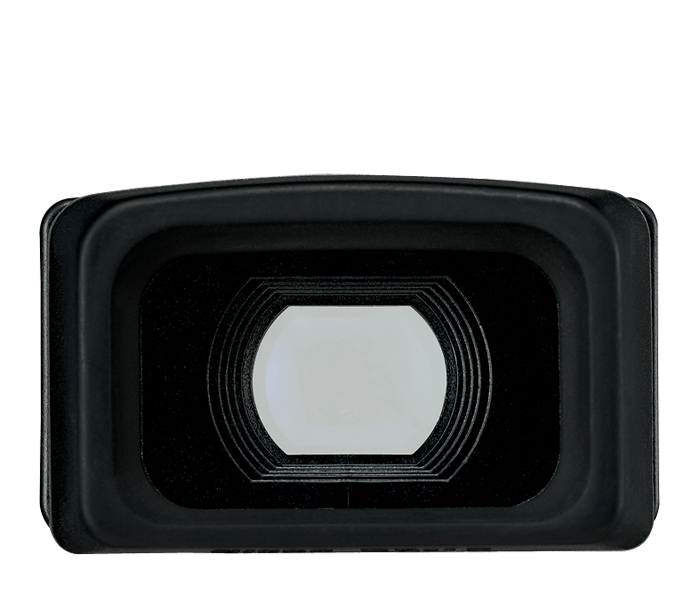
Correction Pieces (DK-20C):
These are covered in the above section under the discussion of correction pieces for circular attachment pieces.
DK-5
The DK-5 isn’t exactly a viewfinder replacement, but is instead a plastic piece that slides into a rectangular viewfinder slot to prevent light from entering the prism/body and affecting exposure in long-exposure modes. Circular-viewfinder bodies include a switch that closes a built-in shutter on the inside of the viewfinder in order to block such light.
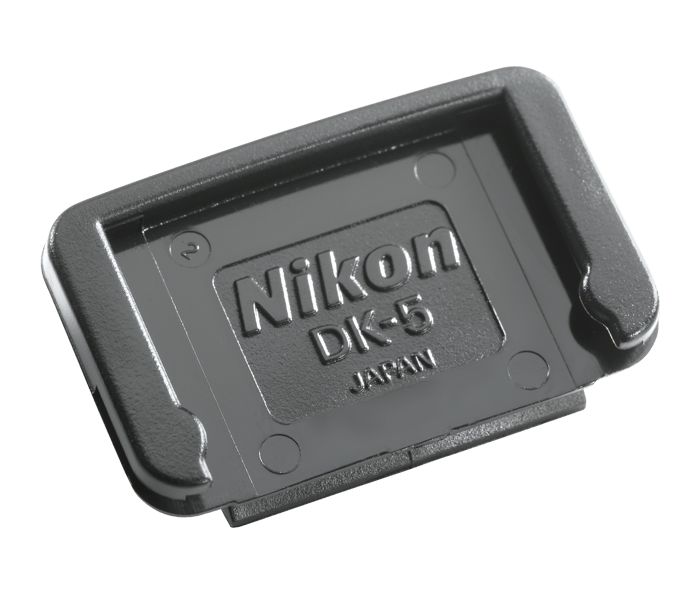
For long-exposure, nighttime, and/or astrophotography shooters, the DK-5 helps block unwanted light from entering through the rear eyepiece of cameras with rectangular viewfinders. Nikon cameras with circular viewfinders feature a built-in shutter for this purpose that doubles as a lock/unlock switch for replacing viewfinders and/or eyepieces.
Viewfinder Accessories
Aside from changing out the piece of glass in front of your eye, various manufacturers have other viewfinder accessories that help you capture different angles in various shooting scenarios.
DR-5 Right-Angle Finder
The DR-5 is Nikon’s nicest, most modern go-to right-angle finder, allowing you to rest at a more comfortable angle while shooting at lower-than-chest levels for macro, product, table-top or other low-angle shooting types. The DR-5 is built incredibly well, features an independent outer ring to aid in attachment (so you’re not turning the entire piece 360º ten times to get it on), and will itself rotate at its midpoint for viewing from the sides as well — all with minimal loss in light.
I like my DR-5, but a word to the wise: don’t treat this as a waist-level finder for active shooting scenarios at low levels. The angle and orientation in general ends up being rather odd to get used to — it’s just not the same as a waist-level finder. Instead, look to the DR-5 for copy work or for use in other controlled shooting environments where you constantly find yourself bending over and twisting sideways to peer through the finder. A built-in switch that offers 1.1x or 1.2x reproduction values is a really nice touch for this type of work.
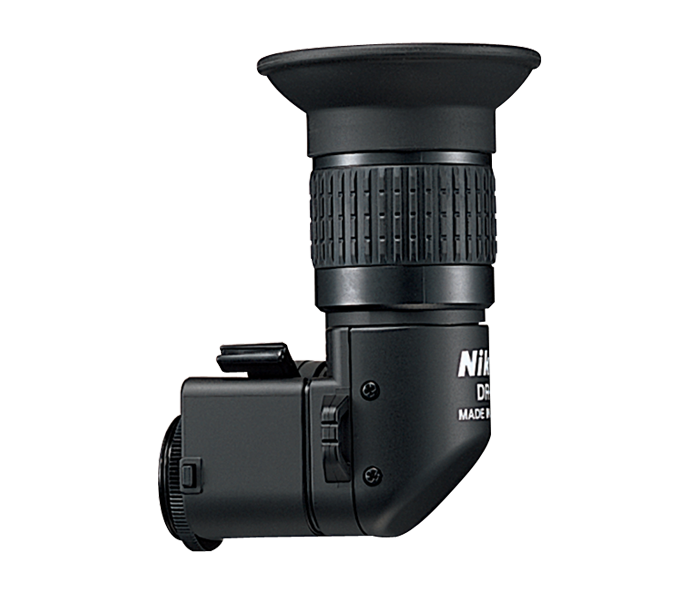
DR-6
For those with rectangular eyepieces, the DR-6 is virtually identical to the DR-5 except for the swapping of the DR-5’s circular attachment point for a rectangular one.
DG-2
The DG-2 is a neat magnifier for those looking at serious macro work. Providing 2x magnification, the DG-2 allows critical focus and composition of the center of the frame for macro work that is often done at extremely shallow depths of field. A flip-up hinge allows the DG-2’s magnification piece to be flipped up and out of the way for viewing at a normal magnification when ready to ensure the entire photograph is framed to your liking.
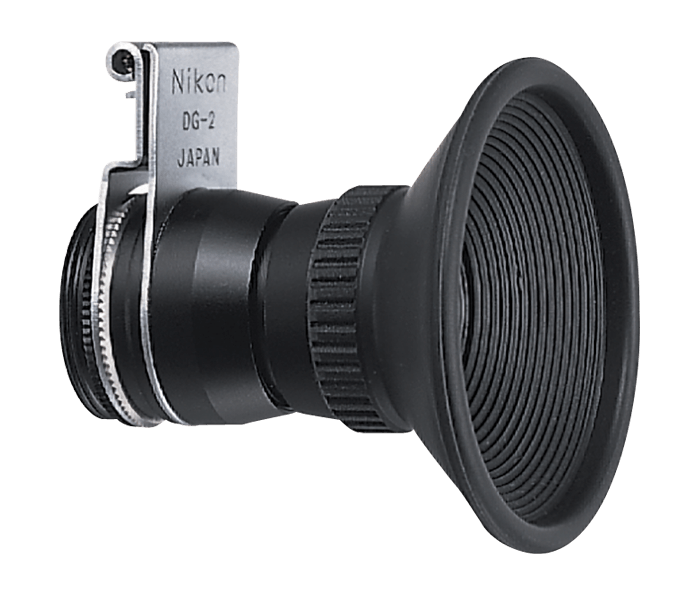
The Nikon DG-2 2x flip-up magnifying viewfinder requires either the DK-18 or DK-22 eyepiece adapter for circular or rectangular attachments, respectively.
DK-18
For some reason, the DG-2 wasn’t made to attach directly to the standard circular attachment point of Nikon’s pro cameras, but instead requires an eyepiece adapter, the DK-18. So if you’re going to go for the DG-2, add one of these to your cart while you’re at it.

DK-22
The DK-22 (mentioned above in the DK-20s section) adapts the DG-2 directly to cameras with rectangular attachment points.
Rubber Eyecups
Rectangular eyepieces come with sturdy, non-enveloping rubber eyecups for which larger versions are simply not made. However, circular eyepieces can benefit from the use of the DK-19 Rubber Eyecup. There are knock-off versions of this online, but the DK-19 itself works quite well, collapsing when not needed and popping out when the sun is in your way. Installing it requires sandwiching the accessory between the attached eyepiece and an accessory ring included with the DK-19.
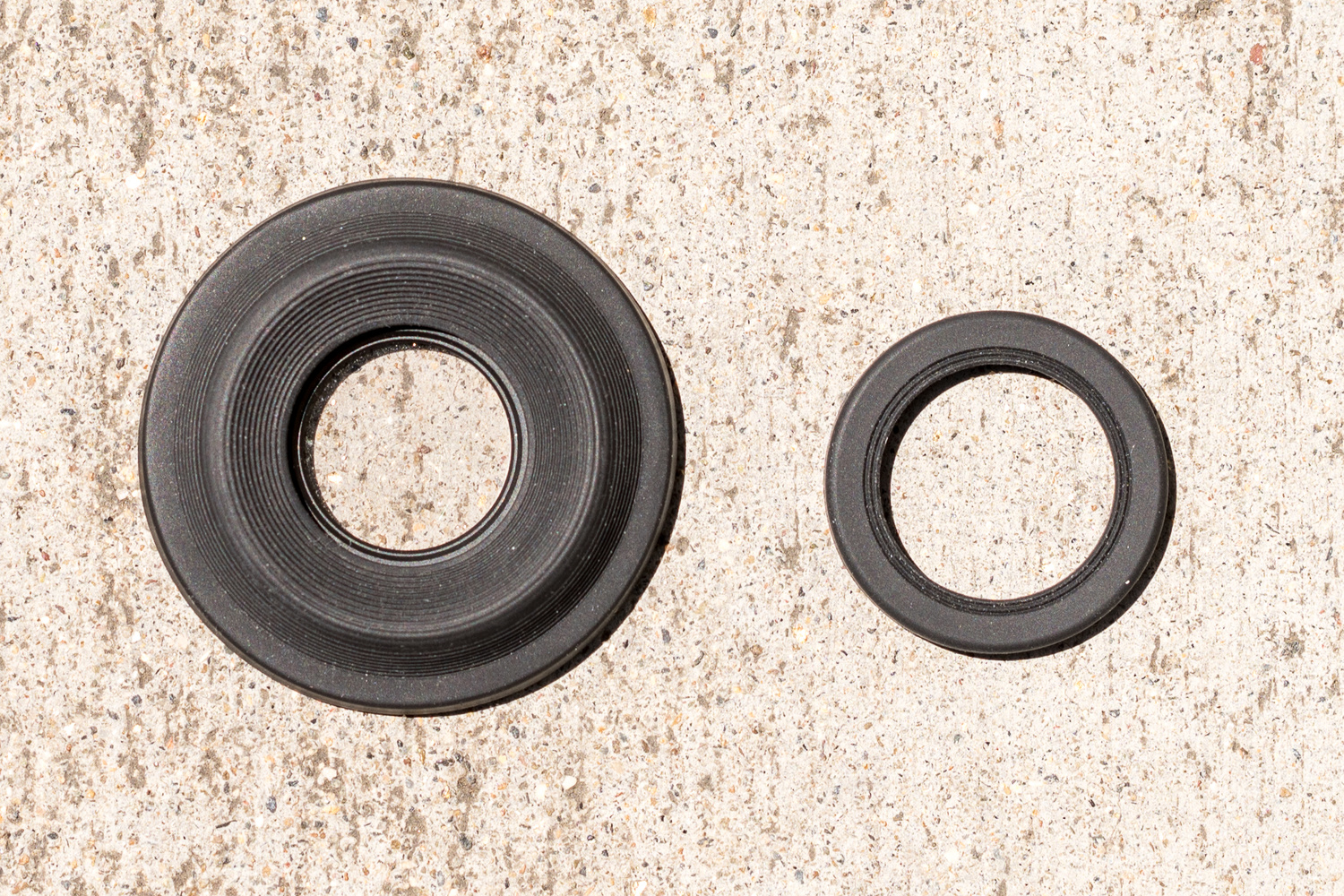
Here, the DK-19 rubber eyecup is compared to the interchangeable standard rubber ring on the outside of most circular eyepieces for Nikon DSLRs. While it is collapsed here, the eyecup pops out when in use to provide added protection from the intrusion of bright light into both the viewfinder and into your eye while shooting.
Canon also has some eyepiece/viewfinder accessories similar to Nikon's offerings, but not quite as robust, while other brands such as Sony, Fuji, etc., seem to barely offer replacement pieces. But check with your brand to see what's available and what might make your shooting just a hair easier. You can see all of Canon's eyepiece options here, or go to their website to select accessories for your particular camera model so you don't have to sift through all of the options available for every model.
One last quick tip: if you're looking to save a little and/or want a few other options (mostly for comfort), check out Vello's third-party line of eyepieces for Nikon cameras. The same company also makes eyepieces for other brands as well.








shoutout to the 20 eyepieces I've replaced on my D750.
That's the worst part of the camera. Really wish Nikon would fix that after-the-fact with an updated, tighter replacement viewfinder. What a pity.
I would love a replacement for it that has a shutter built in for long exposure photos.
Next time you need to replace one, a tiny piece of blutack pushed into the grip keeps it nicely in place.
You're going to laugh at this. I replaced 2 eye pieces on my bodies and secured them with a small amount of gorilla glue.
after two weddings, one of the eye pieces ripped the rubber off and I have the plastic frame remaining, securely glued to my body. Yeah, I'm an idiot lol
Oh man, maybe you could glue some rubber back on there.
Nice article.
hey dan, in the article above it says you cant use it for low angles.. could you use it like a waist leave finder for say street documentary?
You can use it that way, but it's definitely not quite as useful as a true waist-level finder in that case because you still have to put your eye right up to it. However, if the goal is to not look through a camera and directly "at" your subject to stay a little more subtle, this can do that much for you. But definitely 90% of the reason a WLF works for that is because people aren't as used to assuming (or seeing) a literally waist-level-held camera is in the process of photographing them. So...up to you.
Very well written and researched, except you have the DR-5 / 6 mixed up.
The DR-5 is for round eyepieces. DR-6 is for rectangular.
Anyone use the Hoodman replacement eye cup? I find it to be better than the stock one for my D810 and it completely seal off ambient light, making it easier to concentrate on the composition of my image.
https://hoodmanusa.com/cgi/commerce.cgi?preadd=action&key=H-EYEN22S
I wish Nikon (or somebody) made an oversized 1.x magnifier that didn't vignette the viewfinder. It really comes in handy when manually focusing using an E screen in a digital body. Modern digital bodies for some reason don't have the same eyepiece magnification as my old F and F2 prisms. I can easily manually focus with my F or F2, it's just not the same on my D600, which now also has an E screen. I have plenty of Ai optics that I still make use of, and can really appreciate something like that. I've now purchased several third-party units that supposedly did not vignette, but they do. A non-vignetting magnifier coupled with the E screen would make for quick manual focusing on a digital body.
Thanks,a very informative article from a +3 diopter user
"For some reason, the DG-2 wasn’t made to attach directly to the standard circular attachment point of Nikon’s pro cameras, "
The reason is that the DG-2 dates back to the Nikon F2 era, and all the F2s, Nikkormat, FEs, FMs, FA, even early F3 all used a 19mm eyepiece thread. 22mm came later.